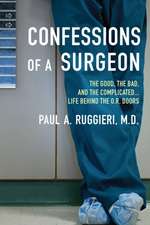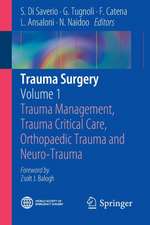Resuscitation and Life Support in Disasters, Relief of Pain and Suffering in Disaster Situations: Proceedings of the International Congress on Disaster Medicine, Mainz, 1977, Part II: Disaster Medicine, cartea 2
Editat de R. Frey, P. Safaren Limba Engleză Paperback – sep 1980
Preț: 718.46 lei
Preț vechi: 756.27 lei
-5% Nou
Puncte Express: 1078
Preț estimativ în valută:
137.47€ • 143.54$ • 113.78£
137.47€ • 143.54$ • 113.78£
Carte tipărită la comandă
Livrare economică 04-18 aprilie
Preluare comenzi: 021 569.72.76
Specificații
ISBN-13: 9783540090441
ISBN-10: 3540090444
Pagini: 304
Ilustrații: XX, 282 p. 37 illus.
Dimensiuni: 170 x 244 x 16 mm
Greutate: 0.49 kg
Ediția:Softcover reprint of the original 1st ed. 1980
Editura: Springer Berlin, Heidelberg
Colecția Springer
Seria Disaster Medicine
Locul publicării:Berlin, Heidelberg, Germany
ISBN-10: 3540090444
Pagini: 304
Ilustrații: XX, 282 p. 37 illus.
Dimensiuni: 170 x 244 x 16 mm
Greutate: 0.49 kg
Ediția:Softcover reprint of the original 1st ed. 1980
Editura: Springer Berlin, Heidelberg
Colecția Springer
Seria Disaster Medicine
Locul publicării:Berlin, Heidelberg, Germany
Public țintă
ResearchCuprins
Preface to the Series.- List of Authors.- Resuscitation and Life Support in Disasters.- Stages of Resuscitation and Life Support in Disasters.- Teaching Life Saving First Aid to the Population at Large.- Extended Rescue Action by Members of Rescue Organisations.- Education of Medical Students in Emergency Medical Services (Disaster Medicine) in Sweden and Norway.- Unexpected Results from an Evalution of Basic Life Support Training.- Indwelling Central Venous Catheters for the Critically 111 Patients.- A Combined Oxygen Resuscitator, Analgesic and Anaesthetic Machine for Use in Disaster Situations.- Requirements for Manually Operated Resuscitators for Use in Disaster Situations.- ECG Telemetry Transmitter, a Vital Tool for Emergency Medical Technicians in Rescue Line.- Use of Modified Liquid Gelatins in Transfusions - in France.- The Possibilities, Requirements and Usefulness of an Immediate Prophylaxis as well as of the Treatment of Traumatic Shock in the Field.- Volemic Re-equilibration with Noncolloidal Isotonic Solutions Under Everyday and Natural Disaster Circumstances.- Possibilities of Oral Fluid Substitution Under Disaster Conditions.- Potential Time Economy in Resuscitation During Disasters by Use of Low Energy, Direct Current, First Shock in Human Cross Chest Ventricular Defibrillation.- Changes in Lipid Metabolism Following Bum Injuries — Consideration of Therapeutic Measures.- 2. Relief of Pain and Suffering in Disaster Situations.- Relief of Pain and Suffering in Disaster Situations.- Requirements for Medicinal Pain Control and Sedation in Disaster Situations.- Techniques of Administration of Nitrous Oxide/Oxygen Mixtures in the Emergency Situation.- Analgesia in Mass Accidents.- Total Spinal Block for Sequelae After Head and Neck Injuries.- AnalgesicOnset Time of IV Butorphanol in Postsurgical Patients.- Assessment and Anesthesia for Multiple Trauma Patients.- The ‘Tri-Service’ Anaesthetic and Resuscitation System.- Anaesthesia for Battle Casualties in Nigeria.- The Use of Ketamine Hydrochloride for Relief of Pain and Suffering in Disaster Situations.- Regional Anesthesia for Disaster Situations.- General and Local Anaesthesia in Disaster Situations.- Anesthesia Procedures for Disaster Cases in Medicine.- Hypnosis as Emergency Treatment for the Mentally 111 and in Disaster Situations.- 3. Workshops: 3.1 Resuscitation.- Experience of Four Repatriation Flights.- The Doctor’s Dilemma — When not to Resuscitate.- Pancommunity Impact of Basic and Advanced Cardiac Life Support Upon Coronary Death Rate.- A Medical Rescue Team for Motor Racing Events.- The Possibilities of Developing Simulators for Lifesaving Measures.- The Training of Medical Students in Emergency Medicine and Disaster Management.- Hyperbaric Chamber for Sport Diving Accidents.- Evaluation of Emergency Medical Services System in the United States.- International Activities in the Emergency Medical Services Project.- Emergency Medical Services (EMS) Systems in the United States, Progress Report and Program Projections.- A Systems Approach to Emergency Medical Care.- Evaluation of Fresh Isolated Craniocerebral Traumas Immediately After Hospitalization.- Mobile Intensive Care Unit as a Catastrophe Unit.- Levels of Urgency for Surgical Treatment in Case of Disaster.- Advanced Life Support by Paramedics.- Planning and Developing a Community Hospital Disaster Program.- Basic and Advanced Life Support in the Water, Lifesaving Chain of the Bulgarian Red Cross.- Resuscitation Research and Evaluation in Disaster Medicine.- Life Support Education: fromPhysician Specialists to Lay Public.- Tri-Service System for Anaesthesia and Resuscitation.- Training Program of the Rescue Services — Forefront of Disaster Aid.- Proposals for Color and Symbol Coding of Equipment, Instruments and Medications.- Grand Rapids Police. Emergency Medical Technician Program.- Emergency Medical Care: a Police System.- Organization of Emergency Cardiac Care in London, Ontario, Canada.- Nasopharyngeal Tube.- Requirements for Aspiration Apparatus Used Under Disaster Conditions.- 3.2. Intravenous Fluids.- Recommendations for the Standardization of Infusion Therapy and Parenteral Nutrition in Disaster Situations.- Indication for Blood, Blood Derivatives, and Colloidal Plasma Expanders in Disaster Situations (J. Kilian and A. Ganzoni).- Initial Infusion Therapy in Bum Casualties Under Disaster Conditions.- Supraclavicular Puncture and Catheterization Using the Alpha System.- 3.3 Relief of Pain and Suffering.- Textiles in the Light of Anesthesia.- Problems of Anesthesia and Resuscitation of the Victims of the Bulgarian Earthquake.- Gammahydroxybutyric Acid — It Effect on Serum Enzymes and Energy Metabolism During Anesthesia.- The Value of Ketamine in Emergency Cases.- Clinical Experience with an Intravenous Combination Anesthesia and Respiration with an AMBU Bag.- Entonox in Immediate Care.- Evaluation of New Combination Anesthesias for Disaster Situations.- Experience of Ketamine and Diazepam Anaesthesia in Field Hospital Conditions.- Postoperative Pain Relief: in a Developing Country.- 3.4 Free Topics.- EMS and its Role in Disaster Medicine.- WHO’s Role in Emergency Relief Operations.- Development of a Government Organized Emergency Health Services System in British Columbia.- Summary of the Congress Recommendations by the Session andWorkshop Chairmen.- Conclusion of Congress.






